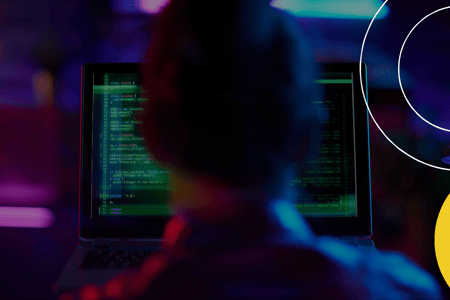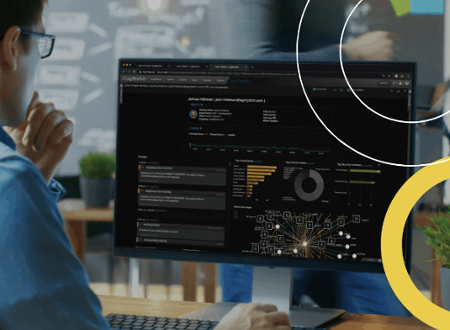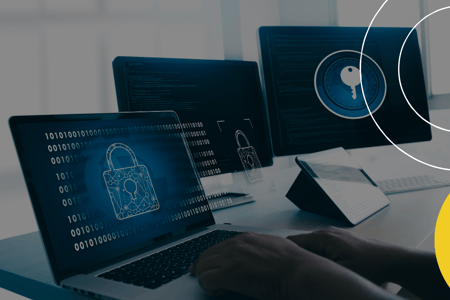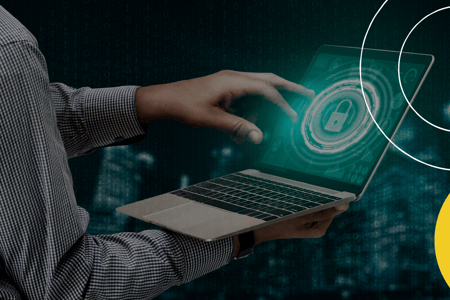The CISO's Guide to Managed Security Services
Introduction
Picture this: Finance is questioning IT spend, and your team just spotted a suspicious login attempt. With security threats and time, budget, and resource demands, the hamster wheel never slows. Turn to managed security services (MSS) to regain control.
Download a PDF version of this guide by filling out this form, or keep scrolling to learn more.

What Are Managed Security Services?
Why Organizations Are Turning to MSSPs
Core Benefits of Partnering with an MSSP
Key Technologies Used in Managed Security Services
The Six Phases of Incident Response
MSS and Security Frameworks
How to Select the Right MSSP
Demonstrating ROI for MSS
Why MSS Is a Strategic Security Investment
- What Are Managed Security Services?
- Why Organizations Are Turning to MSSPs
- Core Benefits of Partnering with an MSSP
- Key Technologies Used in Managed Security Services
- The Six Phases of Incident Response
- MSS and Security Frameworks
- How to Select the Right MSSP
- Demonstrating ROI for MSS
- Why MSS Is a Strategic Security Investment

What Are Managed Security Services?
Managed security services involve outsourcing the monitoring and management of an organization's security systems and tools. This may include security information and event management, firewalls, antivirus, and intrusion detection and prevention.
Between limited in-house resources, expertise, and time constraints, few organizations have the capacity to continuously manage their security infrastructure on their own. Managed security service providers (MSSPs) step in with the expertise to handle large volumes of security events.
Fully Managed vs. Co-Managed MSS Options
You have your choice between two MSS models, depending on your organization's resources and individual needs:
- Fully managed services put the provider in the driver's seat. Your trusted expert owns and manages any security tools they deploy on your behalf, making cybersecurity more accessible. Your partner provides complete protection, so you don't need to devote additional time and resources to security.
- Co-managed services fit the bill if you have a bit of know-how. This model is ideal for organizations that own security tools—even if you can't manage them around the clock. Flexible 24/7 monitoring divides the burden between your in-house team and expert partner, who can also build out your security operations center (SOC) to expand your capabilities.
Resources

How Managed Security Services Work
More and more organizations are investing their security budgets into managed security services. An evolving threat landscape requires skilled security talent and expertise, yet there is a major imparity in finding qualified talent, and a need to monitor and manage security events on a 24x7x365 basis.
Read More
Quick Guide: Security as a Service (SECaaS)
Security as a Service (SECaaS) allows organizations to outsource challenging security tasks like log monitoring and management, incident response, and reporting to a third party or managed security service provider (MSSP).
Read More
Quick Guide: The 5 Essential MSSP Technologies
Managed security services (MSS) create significant business opportunities for organizations of all types. These security services enable accelerated time to security value and help solve the various security challenges presented in today's security environment.
Read More
Why Organizations Are Turning to MSSPs
New threats every day and a lack of capacity and expertise have organizations scrambling to protect against and prevent them. MSSPs are perfectly poised to answer your biggest concerns.
Cybersecurity Threats and Talent Shortages Are Growing
The chasm between the number of cybersecurity threats and qualified security professionals is growing. As of 2025, the U.S. only has enough workers to fill 74 percent of cybersecurity job openings. Companies are playing catch-up as smaller staffs face larger workloads and burnout—and vacancies remain unfilled.
MSSPs fill the talent gap, offering a reliable way to keep an eye on security threats.
Organizations Save Money and Access Specialized Expertise
Just one in-house security employee commands a salary of at least $90,000, plus benefits. If you need an entire team, this adds up quickly. MSSP experts work at a fraction of the cost of an internal security team.
Cost of a Full Security Team vs. MSSP
- Vulnerability and configuration management: $90,000-$136,000 salary, plus hardware/software licensing
- Penetration testing: $97,000-$136,000, plus hardware/software licensing
- Security engineering: $90,000-$143,000
- Audit and compliance: $90,000-$156,000, plus software licensing
- Project management: $90,000-$136,000, plus software licensing
- Management: $130,000-$195,000
MSSPs Act as Extensions of Internal Teams
As the threat landscape grows, in-house teams feel the pressure to protect. Certified security experts, such as engineers, analysts, and consultants, provide a lifeline through SOC monitoring. Their advanced visibility and up-to-date threat intelligence support a defense-in-depth strategy, taking a layered security approach to mitigate threats and vulnerabilities.
Resources

10 Managed Security Service Benefits To Know
Managed security service (MSS) or outsourced security services are a new reality for businesses of all sizes. Hiring an MSSP offers more than a few advantages to an organization's security team. Your team can start to focus on strategic security projects while the MSSP handles the day-to-day monitoring and management of your security environment.
Read More
Criteria for Selecting Your Managed Security Services Provider (MSSP)
An MSSP brings a unique set of strengths to your overall security strategy. A managed security services provider (MSSP) can accelerate your time-to-value with security, as they bring a mature set of standards, processes, and procedures to the table, benefiting your security maturity level as well. Standout MSSPs will offer management, administration, monitoring, response, and reporting as it relates to the security incidents throughout your enterprise. These critical areas of security can become overwhelming for an organization that is scaling up, or is already mitigating existing risks.
Read More
Core Benefits of Partnering with an MSSP
Extend your team's capabilities with expert managed security services. By extending your capabilities with the latest threat intelligence, saving you money, and providing day-to-day monitoring, an MSSP can be game-changing. Consider various key perks.
24/7 Threat Monitoring and Detection
Give your business visibility into advanced threats with a global security footprint. Managed security services offer global 24/7/365 SOCs, so you get security infrastructure equipped with the latest technologies for analysis, correlation, and prioritization.
MSSP partners may engage in a few key activities to support you:
- Threat monitoring: Analysts evaluate data to determine if incidents should be turned into security events.
- Threat hunting: Analysts proactively look for anomalies and unusual endpoint activities instead of waiting for alerts or security incidents.
Incident Response
Bad actors get smarter each day, putting you at risk no matter your security posture. MSSP teams remediate incidents that sneak past your defenses, patching software and pushing out new antivirus signatures while investigating each security event and containing the threat(s).
Security Intelligence
Get real-time visibility into global threats. Managed security services help organizations proactively detect and respond to threats, offering stronger defenses against zero-day attacks, emerging vulnerabilities, and ransomware.
Regulatory Compliance Support
Organizations have enough to worry about without adding compliance to the list. MSSPs provide risk management and compliance expertise across PCI DSS, HIPAA, FISMA, SOX, ISO, and FFIEX, allowing you to stay focused on the business. Partnering with managed security services makes it easier to protect key assets and navigate changing regulations and security challenges. The pros understand every standard in the book and will apply security strategies to match.
Improved Time to Value with Cutting-Edge Tools
Urgency is a tremendous motivator, and an MSSP gets you up to speed. Rapidly advance your security operations compared to hiring, training, and deploying your own security team and tools.
Resources

10 Managed Security Service Benefits to Know
Managed Security Services or outsourced security services are becoming a new reality for businesses of all sizes. Hiring an MSSP offers more than a few advantages to an organization's security team. Your team can start to focus on strategic security projects while the MSSP handles the day-to-day monitoring and management of your security environment.
Read More
How Managed Security Services Work
More and more organizations are investing their security budgets into managed security services. An evolving threat landscape requires skilled security talent and expertise, yet there is a major imparity in finding qualified talent, and a need to monitor and manage security events on a 24x7x365 basis.
Read More
Criteria for Selecting Your Managed Security Services Provider (MSSP)
An MSSP brings a unique set of strengths to your overall security strategy. A managed security services provider (MSSP) can accelerate your time-to-value with security, as they bring a mature set of standards, processes, and procedures to the table, benefiting your security maturity level as well. Standout MSSPs will offer management, administration, monitoring, response, and reporting as it relates to the security incidents throughout your enterprise. These critical areas of security can become overwhelming for an organization that is scaling up, or is already mitigating existing risks.
Read More
Key Technologies Used in Managed Security Services
Managed security services help organizations like yours stand up to an ever-increasing list of security challenges. But they don't do it alone. Several core technologies help make MSS initiatives successful.
Security Information and Event Management (SIEM)
SIEM technology allows managed security services to be the eye in the sky against security incidents by detecting unauthorized system access. MSSP's use SIEM to gather and analyze security logs in one place, comparing organizational data against thousands of security events to spot malicious activity and generate alerts.
But whether or not this works depends on how well the technology is tailored to your specific data, compliance needs, and security policies. If your partner can suss out what matters most, they can better customize controls and create reports that align with your goals.
Think a SIEM might help? Choosing a solution takes just a few steps:
- Define goals: Determine whether the SIEM will be used for threat detection, real-time monitoring, compliance, or all three.
- Assign management: Decide on your MSSP — with a dedicated team and expertise — to manage and support the SIEM.
- Deploy the plan: Understand how to deploy the SIEM, including on-premise or cloud-based infrastructure, integration, and setup.
- Ensure customization: Opt for a SIEM that can be tailored to generate relevant alerts and identify critical threats with customizable event correlation rules.
Security, Orchestration, Automation, and Response (SOAR)
Trying to enhance security ops efficiency? Streamline incident response and cut down response times by automating repetitive tasks and integrating key tools. SOAR enables security teams to focus on more complex threats and coordinate efforts across security systems.
SOAR plays several important roles
across cybersecurity operations:
- Orchestration: Coordinate your security systems to create a centralized view and streamline communication across firewalls, intrusion detection systems, SIEMs, and other tools.
- Automation: Reduce the need for human intervention across incident response. Automating data enrichment, IP blocking, or quarantining infected endpoints frees analysts up for more critical investigations.
- Response: Adopt policies and workflows to better prioritize, assess, and act against threats. SOAR facilitates case management to track and document incidents.
Endpoint Detection and Response (EDR)
Continuously monitor and respond to threats. EDR enables stringent protection of endpoints, such as laptops, desktops, servers, and mobile devices, beyond what most antivirus programs could provide. Improve insights into endpoint behavior to proactively identify, analyze, and neutralize cyberattacks, from ransomware to advanced persistent threats.
EDR is your most proactive investigator, covering the full spectrum of cybersecurity activity:
- Monitoring and data collection: Continuously gather and analyze data across endpoints to identify suspicious activity.
- Threat detection: Spot threats that evade traditional security measures by incorporating behavioral analytics, machine learning, and threat intelligence.
- Investigation and analysis: Understand the context of threats, digging deep into each one to understand their scope and impact.
- Incident response: Facilitate rapid response to neutralize and contain threats and restore affected systems.
Email Threat Prevention (ETP)
Your most common communication channel is still one of the most vulnerable. Implement ETP to add a layer of security to better detect the most damaging threats, such as phishing and ransomware.
Mitigate your risk of data breaches by analyzing emails before users even think of clicking them. ETP can be integrated into your security platform while combining various tactics to block attacks in real time, including:
- Threat intelligence
- Data sanitation
- Advanced scanning
Network Detection and Response (NDR)
Continuously monitor and analyze network traffic to identify threats that slip past your firewalls. NDR is critical for a comprehensive security strategy, working alongside SIEM and EDR tools and incorporating advanced techniques so you can identify and respond to suspicious network activities:
- Continuous monitoring and analysis: Analyze real-time network traffic, from north-south (inbound/outbound) to east-west (lateral) traffic, so you can understand normal network behavior.
- Threat detection: Leverage machine learning and behavioral analytics to isolate potential threats, such as malware, insider threats, or lateral movement by attackers.
- Automated response: Initiate automated actions against threats, from isolating affected network segments to integrating with EDR or SOAR platforms for containment.
- Contextual visibility: Understand network activity ranging from user and device interactions to data flow to better investigate individual threats.
Cloud Access Security Broker (CASB) / Network Platform Analytics (NPA)
Improve security and threat management. CASBs and NPA secure cloud and mobile environments, respectively.
Implement CASB security policy enforcement points as intermediaries between users and cloud applications to monitor and enforce security, compliance, and governance policies for cloud applications. CASB deployment can be API-based, proxy-based, or hybrid to provide optimal security coverage for your use case, helping to improve:
- Visibility: Obtain insights into cloud app usage, including shadow IT (unauthorized apps), user activity, data flows, and potential risks.
- Data security: Protect sensitive cloud data via encryption, tokenization, access controls, and data loss prevention policies.
- Threat protection: Combine threat intelligence and advanced analytics to enable early detection of malware, phishing attacks, compromised accounts, and insider threat.
- Compliance: Meet regulatory requirements — from GDPR to HIPAA — through strict policy enforcement, audit logging, and reporting.
Concerned about mobile? Deploy NPA to analyze network behavior across managed mobile devices. NPA provides visibility into network traffic without compromising confidentiality by only inspecting header data and surrounding context. It can differentiate legitimate and fake application traffic to reveal potential impersonation threats.
NPA supercharges your:
- Network visibility: Collect information about network traffic patterns and usage on managed devices, including source/destination IP addresses, port numbers, protocols, and traffic sources.
- Problem detection: Identify network misconfigurations, suspicious usage patterns, and potential threats.
- Device management: Simplify troubleshooting, cause analysis, and remediation for network-related issues on mobile devices.
Vulnerability and Compliance Management
Vulnerability and compliance management work together to safeguard your systems, data, and even your reputation. While vulnerability management monitors to identify security weaknesses, compliance management mandates risk mitigation and encourages vulnerability management programs.
These processes support a more resilient security posture while ensuring regulatory adherence. Add this tag team to enhance your cybersecurity strategy.
Vulnerability and Compliance Management Benefits
| Vulnerability Management | Compliance Management |
| Proactively reduce risks: Identify and address weaknesses to prevent exploitation. | Adhere to rules and regulations: Align internal systems and policies with laws and standards. |
| Minimize the attack surface: Reduce entry points for cyberthreats | Avoid legal and financial penalties: Mitigate noncompliance repercussions, such as fines and lawsuits. |
| Continuously monitor: Regularly evaluate to stay ahead of threats. | Monitor and audit on an ongoing basis: Track compliance metrics, using audits to ensure adherence. |
| Leverage advanced security tools: Implement scanners, pentesting, patching, and threat intelligence. | Maintain policies and procedures: Establish and enforce a structured compliance framework. |
|
Prioritize risk-based remediation: Focus on fixing the highest-impact vulnerabilities. |
Build trust and reputation: Follow security best practices to show stakeholders your commitment to data protection. |
MSSP Is Proactive, and MSS Is Reactive
Managed security services use either proprietary or publicly available SIEM tools to manage security. The direction you turn depends on your organization's needs.
Software-Agnostic MSSP
| Situation | Why It Works |
| Already using a SIEM | Avoids disruption to your current security infrastructure |
| Concerned about long-term flexibility | Prevents vendor lock-in and supports evolving needs |
| Frequently adopt new tools | Maintains compatibility and integration across changing tech |
Proprietary MSSP
| Situation | Why It Works |
| No security software in place | Offers a complete, out-of-the-box solution to get started quickly |
| Needs fast deployment | Speeds up implementation with tightly integrated services |
Resources

Integrating SIEM Within Compliance Programs
At their core, information security and compliance seem like topics that should go hand in hand: InfoSec deals with the daily functions of identifying and responding to threats, while compliance includes responsibilities of implementing IT security controls and effective governance.
Read More-1.png?width=450&length=450&name=Don%E2%80%99t%20Be%20the%20Easy%20Target%20Top%20Cybersecurity%20Mistakes%20Companies%20Make%20(and%20How%20to%20Avoid%20Them)-1.png)
Don’t Be the Easy Target: Top Cybersecurity Mistakes Companies Make (and How to Avoid Them)
All too often, we hear the phrase “what if?” But in today’s climate, it’s not a matter of if but when, and no organization is immune to cyberattacks. Even companies that believe they have robust cybersecurity defenses can be caught off guard by sophisticated and determined attackers.
Read More
The Six Phases of Incident Response
Prepping for security incidents is extremely difficult, making MSS and incident response (IR) a critical partnership. IR plans define what constitutes a breach, how the security team will provide support (and tools to help), and steps to mitigate the problems(s). Follow the six phases of IR, using a checklist of questions for each step of the process.
1. Preparation
Is everyone across your team ready to respond effectively? Take a cue from the motto "Always be prepared" by developing security policies, defining roles, and training your team through simulations to strengthen your security posture.
Ask these questions as you go to solidify your approach:
- Are formal security policies documented, communicated, and enforceable?
- Has the organization defined what constitutes a security incident?
- Is there a process for classifying, prioritizing, and logging incidents?
- Have roles and responsibilities been assigned for each phase of IR?
- Who should coordinate with law enforcement or external stakeholders?
- Who will oversee system recovery and restoration after a major incident?
2. Identification
Follow a clear process for detecting and documenting threats. Logging, alerting, and using security tools help to collect and communicate details based on your IR policy.
Aim to answer these questions:
- Who discovered/reported the incident, and when?
- Where was it found (network, system, location)?
- What is the impact on business operations?
- How widespread is the incident across systems or applications?
- Are all findings logged in the IR journal?
3. Containment
Social distancing might not be the fondest memory, but containment works much the same way: Isolate the affected systems to limit the spread of damage.
Ask key questions as you implement temporary fixes in search of a long-term solution:
- Can the threat be isolated?
- Are infected systems separated from healthy ones?
- Are backups available to preserve data?
- Has the team captured forensic images of infected systems?
- Have malware or other threats been removed?
4. Eradication
IR can do to cyberthreats what vaccines do to diseases. Eradication patches vulnerabilities, fully removes threats, and strengthens defenses to prevent a recurrence.
Check these boxes to find your "cure":
- Are systems being patched and hardened?
- Will reconfigurations help any apps or systems?
- Have all attack entry points been identified and sealed?
- Are all malicious elements removed?
- Are security controls in place to prevent recurrence?
5. Recovery
It takes time to get back to normal. Once you restore affected systems, it's easier to monitor for lingering threats.
Here's what you need to ask:
- Where are backups being pulled from?
- When will restored systems return to production?
- Which business functions will be restored first?
- Are system testing and validation complete?
- Is recovery documented for later reference?
6. Lessons Learned
Did your plan work or not? Take time to reflect on your IR process. Document and assess your findings to improve future responses based on what you learned.
You'll want to understand:
- Has all documentation across IR phases been completed?
- If a formal incident report is available, does it detail remediation actions?
- Will there be a lessons learned session, and who will debrief?
- Have process improvements been identified and documented?
Outsourcing IR to a Managed Security Services Provider
Your incident response could cover everything from detection to response and recovery—and for many, it's too much to manage in-house. MSS can support every step of the process, safeguarding brand reputation, operations, and revenue along the way.
The other problem? Crisis plans often don't involve executive leaders, who need to be at the center of preparing for, managing, and recovering from cyberincidents. Cipher and Fellsway Group are paving the way. The forthcoming joint 2025 State of Crisis Management & Incident Response (CMIR) Report aligns IR with business objectives, helping organizations assess and improve their cybercrisis readiness from the top down.
Resources

5 Helpful Incident Response Checklists
Once you have a good understanding of the phases of incident response, it's time to start developing and implementing incident response checklists that are customized for your business. IR checklists can help your security team efficiently respond to incidents by following a systematic process.
Read More
3 Reasons Why You Need an Incident Response Plan
When reputation, revenue, and customer trust is at stake, it’s critical that an organization can identify and respond to security incidents and events. Whether a breach is small or large, organizations need to have an incident response plan in place to mitigate the risks of being a victim of the latest cyberattack.
Read More
The Core Phases of Incident Response and Remediation
Planning and preparing for unexpected security incidents is perhaps one of the most difficult challenges for security practitioners. With a robust incident response (IR) plan, professionals can follow a foundation or standard for handling incidents.
Read More
Organizing Your Incident Response Plans and Security Framework
Organizing your information security activities within frameworks can be difficult. There are a lot of security frameworks to choose from: NIST, ISO, HIPAA, and PCI-DSS. Each framework provides categorized order in which you can organize your focus and activities. Cipher uses a customized information security framework which describes phases of organized information security activities, each pillar with more finely granular areas of interest. This helps the organizations in building a solid incident response plan template overall.
Read More
MSS and Security Frameworks
Managed security services align with frameworks such as NIST, ISO, COBIT, and PCI DSS. Collaborating with seasoned pros provides risk management and compliance protection.
Support for Detect, Protect, and Respond Functions in NIST CSF
The detect function focuses on developing and executing actions so organizations can quickly identify security incidents. Managed security services collect and detect anomalies and malicious activities by aggregating and correlating logs with SIEM tools.
With MSSPs by their side, organizations that otherwise lack internal resources can better analyze and respond to events; partners follow a system of best practices:
| ✔️ | Establish a baseline of normal network operations and data flows. |
| ✔️ | Analyze detected events to understand attack methods and targets. |
| ✔️ | Aggregate and correlate event data from multiple sources. |
| ✔️ | Assess the impact of security events. |
| ✔️ | Define alert thresholds and incident response processes. |
| ✔️ | Continuously monitor security for data exfiltration and evaluate existing protections. |
| ✔️ | Validate and enhance end-to-end detection processes. |
| ✔️ | Implement gap analysis and tier progression. |
Resources

Why Managed Security Services Aligns Perfectly with Security Frameworks
Leveraging a well-known cybersecurity framework is typically the best practice when creating your overall security strategy. Countless security professionals use NIST, ISO, SANS, COBIT, or PCI DSS as a starting point. Managed security services (MSS) can create a significant opportunity for small to enterprise-sized organizations that need to accelerate their cybersecurity framework adoption.
Read More
Organizing Your Incident Response Plans and Security Framework
Organizing your information security activities within frameworks can be difficult. There are a lot of security frameworks to choose from: NIST, ISO, HIPAA, and PCI-DSS. Each framework provides categorized order in which you can organize your focus and activities. Cipher uses a customized information security framework which describes phases of organized information security activities, and each pillar with more finely granular areas of interest. This helps the organizations in building a solid incident response plan and template overall.
Read More
How to Select the Right MSSP
The biggest advantage of working with an MSSP is quicker time to value across cybersecurity because its expertise across key standards and procedures improves your security maturity. So, how do you choose?
The best providers offer everything from monitoring to reporting, becoming an extension of your team so you can focus on growth. Look for these capabilities when choosing a managed security services provider.
World-Class Security Intelligence & Threat-Hunting Experts
Choosing an MSSP focused solely on managed security services backed by elite threat hunters and intelligence experts. Ask how much revenue comes from MSS to ensure dedication to security.
Compliance & Regulatory Knowledge
Can the provider navigate compliance standards such as PCI DSS, HIPAA, and SOX like the back of their hand? Ensure prospective providers have deep knowledge of regulatory frameworks so you organization can stay audit-ready and ahead of shifting compliance demands.
Threat Detection & Response Capabilities
You're growing—the MSSP should be too. It must have the infrastructure to deliver managed detection and response services and handle large volumes of log data. Ensure timely identification and remediation of threats so you can minimize your risk and downtime.
Dedicated Infrastructure & 24/7 Support
Reap the benefits of a modern technology stack. The MSSP you select should own a SOC to support threat analysis and incident prioritization, complete with real-time dashboards for around-the-clock monitoring.
Diverse & Innovative Technology Ecosystem
Flexible solutions give organizations just what they need. Choose managed security services that offer a flexible ecosystem capable of integrating with your existing SIEM, endpoint protection, and vulnerability management systems—and supporting your security. The right partner may also be able to offer strategic guidance on security assessments and frameworks.
Customer Recommendations and Industry Recognition
Reputation matters. Seek MSSPs that have strong customer testimonials, global presence, and recognized industry accolades. Ringing endorsements such as these confirm their reliability and excellence.
Resources

Criteria for Selecting Your Managed Security Services Provider (MSSP)
An MSSP brings a unique set of strengths to your overall security strategy. A managed security services provider (MSSP) can accelerate your time-to-value with security, as they bring a mature set of standards, processes, and procedures to the table, benefiting your security maturity level as well. Standout MSSPs will offer management, administration, monitoring, response, and reporting as it relates to the security incidents throughout your enterprise. These critical areas of security can become overwhelming for an organization that is scaling up, or is already mitigating existing risks.
Read More
MSSP Software: Agnostic vs. Proprietary
Managed security service providers (MSSPs) use specialized software to monitor the environment of companies they provide services for. Security information and event management (SIEM) programs provide a platform for MSSPs to manage data. An MSSP might use a proprietary program they developed to manage security. MSSPs can also use products available to the public.
Read More
Demonstrating ROI for MSS
Best-case scenario: Your organization invests in cybersecurity protection and never needs to respond to an emergency. So, how do you quantify the value of managed security services?
Unraveling Return on Security Investment (ROSI)
Prove that security is more than insurance. Beckstrom's Law is a common guideline to demonstrate your ROSI—proving that MSS is a measurable investment. It quantifies cybersecurity value using a basic formula to determine the net benefit of an initiative:
Value = Benefit - Security Investment - Residual Loss
Investment means more than hard dollars. Residual loss reflects this by factoring in costs such as lost productivity, remediation, and revenue loss due to security incidents.
Getting Leadership Buy-In
Do we invest or not? What is the bottom line, and why does it matter? Executive members have different opinions on what security measures are necessary—but it's also essential to get their buy-in.
Measure the true cost of your security investment to prove its value and obtain leadership buy-in. Being able to show proof, such as reducing threats by 25 percent or $500,000, moves the needle.
Resources

Return on Security Investment: The Simple Formula
At its core, information security exists to preserve value—the value of intellectual property, transactions, data access, brand reputation, and more. Breach headlines put dollar signs on that mission:
Read More
Why MSS Is a Strategic Security Investment
Managed security services enable faster, smarter, and more scalable security. As threats grow and expertise is harder to come by, MSS helps organizations stay ahead.
Give your organization the resources to stay secure with advanced threat detection, 24/7 monitoring, expert analysis, and rapid incident response. Talk to a Cipher expert today and discover how MSS can enhance your protection.
Speak to a Cipher Expert
In the cybersecurity industry, there’s no substitute for experience.
For more than 20 years, we’ve been dedicated to protecting and supporting organizations like yours so they can thrive in today’s digital world. Our talented team of experts is here to provide leading cybersecurity solutions that are proven to reduce risk, optimize security, and enhance your enterprise IT performance, allowing you to focus on your core business with peace of mind.

Ready to Get Started?
If you're ready to discover how Cipher can transform your organization's cybersecurity capabilities, simply fill out the form below. One of our experts will reach out to schedule a personalized consultation that fits your schedule.
Let's secure your future together.